According to a 2018 survey, nearly 95 percent of Car Safety For pets owners plan on taking at least one overnight trip with their pets. However, traveling with pets in a car requires preparation and considerations for their safety. This article provides essential tips to ensure secure and comfortable car travel for your furry friends.
When it comes to traveling with pets, ensuring their safety is paramount. Just like humans, pets need to be properly secured to prevent injuries and distractions during the journey. By following these car safety tips, you can make traveling with your pets a safer and more enjoyable experience for everyone involved.
Key Takeaways:
- Properly restrain your pets in the car to minimize distractions and potential injuries.
- Gradually acclimate your pet to car travel through short trips before embarking on long-distance journeys.
- Pack a pet travel kit with essentials such as food, water, medications, and identification.
- Avoid hazards and distractions, such as pets riding with their heads out of windows or sitting in the bed of a truck.
- Research pet-friendly accommodations and transportation options when traveling by plane, train, or boat.
The Importance of Pet Restraints
To prioritize the safety of your furry friend and yourself, it is crucial to keep your pet restrained while traveling in the car. Unrestrained pets can not only be a distraction for drivers but also pose serious risks to their own safety in the event of an accident.
When it comes to restraining your pets in the car, the back seat is the safest location. This keeps them away from the airbags, which are designed to protect humans and can be harmful to pets due to their size and positioning.
There are several options for pet restraints, but the most secure choice is using carriers that are strapped to the seat with a seatbelt or other anchor. This ensures that the carrier stays in place even during sudden stops or accidents, providing the maximum level of safety for your pet.
While some pet owners may opt for pet seatbelts, their effectiveness in car crashes is not yet proven. Therefore, it is important to choose a restraint option that has been tested for safety and provides reliable protection for your pet.
“The safety of your pet should always be a top priority when traveling in the car. By using pet restraints, you not only prevent distractions but also minimize the risk of injuries to your beloved companion.”
Keeping your pet restrained in the car is a simple yet crucial step towards ensuring their safety and the safety of everyone in the vehicle. Remember, your pet’s well-being is in your hands, so make pet restraints a part of your travel routine.
Preparing Your Pet for Car Travel
Before embarking on a long trip, it is essential to prepare your dog for car travel by gradually introducing them to shorter trips.
Start with short journeys to help your pet acclimate to car travel. Take them on frequent trips around the block or to nearby destinations. This will help them become familiar with the car environment and reduce anxiety during longer journeys.
During these initial trips, observe your dog’s behavior and comfort level. If they exhibit signs of car sickness, such as excessive drooling or vomiting, consult with your veterinarian for guidance.
Gradually increase the duration of the trips over time. Once your pet seems comfortable during short journeys, you can extend the distance and duration of their car rides. This will help them build confidence and prepare for longer trips.
Keep in mind that some dogs may experience car sickness. To minimize the risk, feed your pet a light meal three to four hours before departing. This will prevent an upset stomach and reduce the chances of car sickness.
During the journey, make regular stops to allow your pet to stretch their legs, go to the bathroom, and have a meal if needed. This will keep them comfortable and prevent any discomfort or restlessness during the trip.
Remember, every pet is unique, and it may take some time for them to adjust to car travel. Patience, positive reinforcement, and gradual exposure will help them become accustomed to car rides and ensure a safe and enjoyable experience for both of you.
| Tip | Benefit |
|---|---|
| Start with short trips | Allows your pet to acclimate gradually and reduces anxiety |
| Observe for signs of car sickness | Enables early intervention and consultation with a veterinarian, if necessary |
| Gradually increase trip duration | Helps your pet build confidence and prepares them for longer journeys |
| Feed a light meal before departure | Prevents car sickness and upset stomach during the journey |
| Make regular stops | Keeps your pet comfortable and prevents restlessness |
Remember, every pet is unique, and it may take some time for them to adjust to car travel. Patience, positive reinforcement, and gradual exposure will help them become accustomed to car rides and ensure a safe and enjoyable experience for both of you.
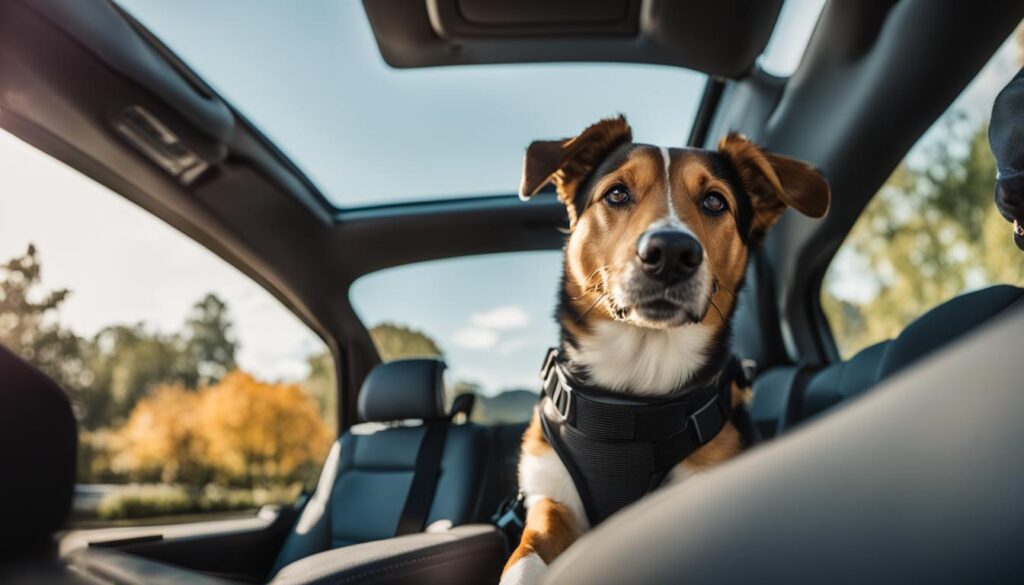
Ensuring Pet Safety During Stops
When making stops during your journey, it’s important to prioritize your pet’s safety. Leaving pets in parked cars can pose significant risks, even if the windows are cracked. The temperature inside a parked car can quickly rise to dangerous levels, potentially causing heatstroke or other severe health issues for your furry friend.
Image:
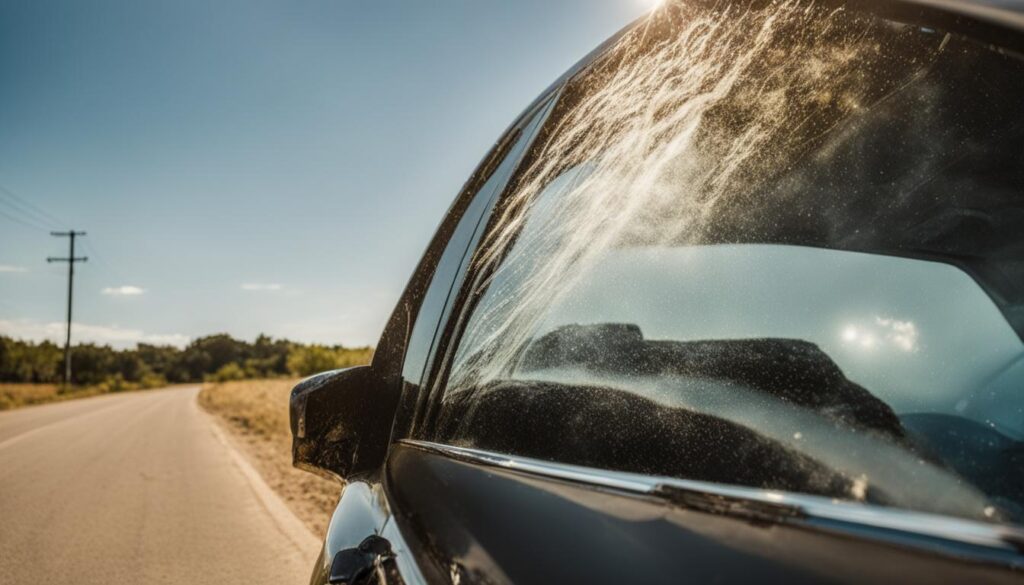
To ensure your pet’s well-being during stops, it’s essential to pack a pet travel kit. This kit should include essential items such as:
- Health records
- Food and water
- Medications
- Bowls
- Waste bags
- Toys for comfort and entertainment
Having these items readily available will help you address your pet’s basic needs and keep them comfortable throughout the journey. Additionally, it’s crucial to have proper identification for your pet, including a collar with an ID tag that contains relevant contact information.
| Essential Items for a Pet Travel Kit |
|---|
| Health records |
| Food and water |
| Medications |
| Bowls |
| Waste bags |
| Toys for comfort and entertainment |
By ensuring your pet has everything they need during stops, you can minimize their stress and make the journey more enjoyable.
Avoiding Hazards and Distractions
Ensuring the safety of your dog during car travel is paramount to protect both your pet and yourself from potential hazards. It is crucial to be aware of common dangers and minimize distractions that can compromise the well-being of your dog and your focus as a driver.
Be Mindful of Hazards
One common hazard is letting your dog ride with their head out of the window. While it may seem enjoyable for them, this behavior can result in injury from flying debris or accidents caused by sudden brakes or turns. It is safer to keep the windows closed or rely on pet-specific window screens to prevent any mishaps.
Dogs riding in the bed of a truck can also be at great risk. Unsecured in the back, they are vulnerable to falling or jumping out, leading to severe injuries or even fatality. Whenever possible, let your dog travel inside the vehicle, either restrained with a harness or secured in an appropriate carrier.
Minimize Distractions
Avoid activities that can distract you while driving, particularly feeding your dog. Providing food to your pet while on the road can divert your attention from the road ahead and compromise your ability to react quickly in hazardous situations. Instead, plan dedicated stops to safely feed your dog, ensuring their nutritional needs are met without compromising your focus on the road.
Additionally, refrain from letting your dog roam freely inside the car during travel. Unrestrained pets can easily become distractions, moving around the vehicle, interfering with your control of the car, or obstructing your view. Confine your dog in a secure space, such as a crate or with the use of harnesses and seatbelts specifically designed for pets.
Remember, your primary responsibility is to safely operate the vehicle, which means keeping your dog secure and minimizing distractions. By doing so, you can maintain a safe environment for both you and your furry companion.
| Common Hazards for Dogs in Cars | Minimizing Distractions |
|---|---|
| Letting dogs ride with their heads out of the window | Avoid feeding your dog while driving |
| Allowing dogs to ride in the bed of a truck | Confining your dog in a secure space |
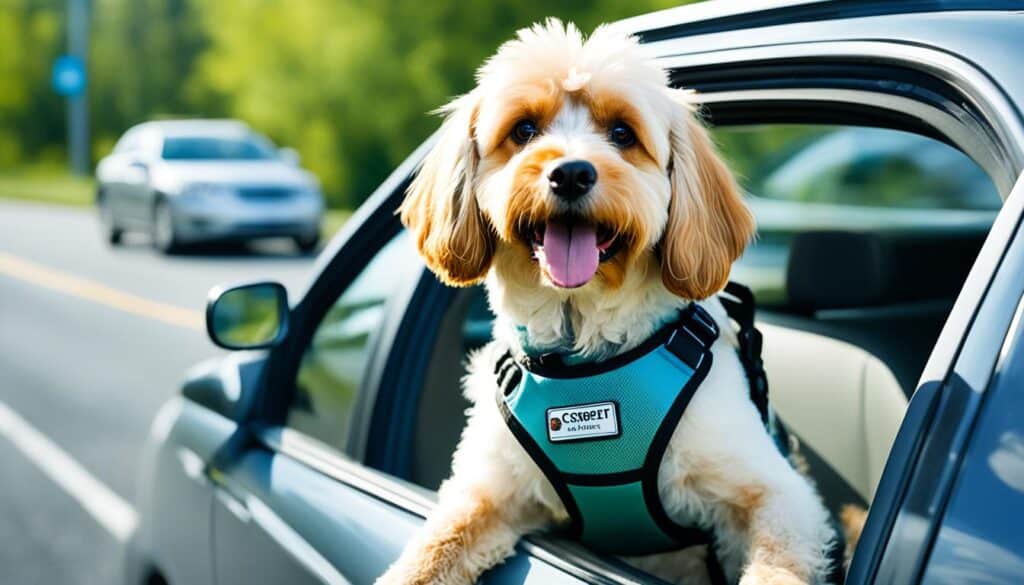
Traveling by Plane, Train, and Boat
When it comes to pet travel, options extend beyond road trips. If you’re planning to take your furry companion on a journey by plane, train, or boat, there are a few additional considerations to keep in mind.
Traveling by Plane
Many airlines allow pets to travel in the cabin or cargo hold, but it’s important to research and understand their specific policies and requirements. Some airlines have restrictions on certain breeds or have size limitations for pets in the cabin. Most airlines also require health certificates, so be sure to schedule a visit to the veterinarian before your trip.
“Traveling by plane with your pet requires careful planning, including familiarizing yourself with airline policies and ensuring your pet is healthy and comfortable for the journey.”
Traveling by Train
While not all train companies allow pets, there are still options available for pet owners. Smaller train companies or international railways may permit pets, but it’s important to check their specific policies and any requirements they may have. For example, some trains may require pets to be in carriers or have documentation of vaccinations.
Traveling by Boat
If you’re planning a cruise or an ocean crossing, some cruise lines do allow pets on board. However, it’s crucial to carefully review their policies and any restrictions they may have on cabin access. Some cruise lines may have designated pet-friendly cabins or specific areas where pets are permitted. Always check with the cruise line in advance to make sure you understand their rules and requirements.
Regardless of your chosen mode of transportation, it’s essential to research and plan ahead for pet-friendly accommodations at your destination. Many hotels and rentals have specific pet policies, so be sure to book accommodations that are welcoming to your furry friend.
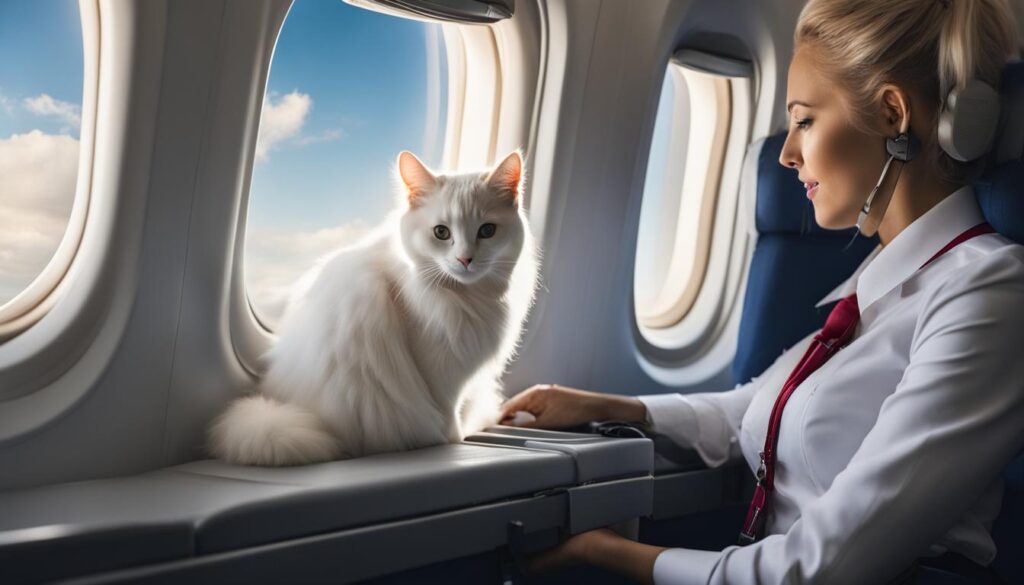
| Mode of Transportation | Considerations |
|---|---|
| Plane | – Research and understand airline policies – Check breed and size restrictions – Schedule a visit to the veterinarian for health certificates |
| Train | – Check if the train company allows pets – Review policies regarding carriers or documentation |
| Boat | – Understand the cruise line’s pet policy – Check for restrictions on cabin access or designated pet-friendly areas |
Ensuring the Right Restraints and Carriers
When it comes to pet safety during car travel, not all restraints and carriers are created equal. To make sure your furry friend stays secure, it’s important to choose the right options. The nonprofit Center for Pet Safety conducts independent crash certification tests to evaluate the performance of different pet restraints in simulated crash scenarios. Unfortunately, many of the pet restraints available on the market do not perform well in these tests, highlighting the need for careful consideration.
One of the recommended options for ensuring pet safety during car travel is a crash-tested dog harness. These harnesses have undergone extensive testing to ensure they can effectively protect your pet in the event of a crash. They are designed to distribute the force of impact over a larger area, reducing the risk of injury. Additionally, carriers with crash protection are also a good choice, as they provide a secure and protective space for your pet.
Choosing the Right Carrier
When selecting a carrier for your pet, there are several factors to consider. First and foremost, make sure the carrier is suitable for your pet’s size and breed. It should be spacious enough for them to stand, turn around, and lie down comfortably. Additionally, opt for carriers that are well-ventilated to ensure your pet gets enough fresh air during the journey.
| Key Considerations for Choosing a Pet Carrier | Features |
|---|---|
| Size and Comfort | Ensure the carrier is spacious enough for your pet to move around comfortably. |
| Crash Protection | Look for carriers that have been crash-tested and provide adequate protection during car travel. |
| Security | Choose carriers with secure latches or closures to prevent accidental openings. |
| Ventilation | Ensure the carrier has proper ventilation to keep your pet cool and comfortable. |
Remember, when using a carrier, always secure it properly in the car to prevent it from moving during the journey. This can be done by using seat belts or other anchoring systems specifically designed for pet carriers. This will help minimize the risk of accidents or injuries should sudden braking or a collision occur.
By choosing a crash-tested harness or carrier and ensuring it is used correctly, you can provide your pet with the safest possible travel experience. Prioritize their safety and make car travel a worry-free and enjoyable adventure for both you and your furry companion.
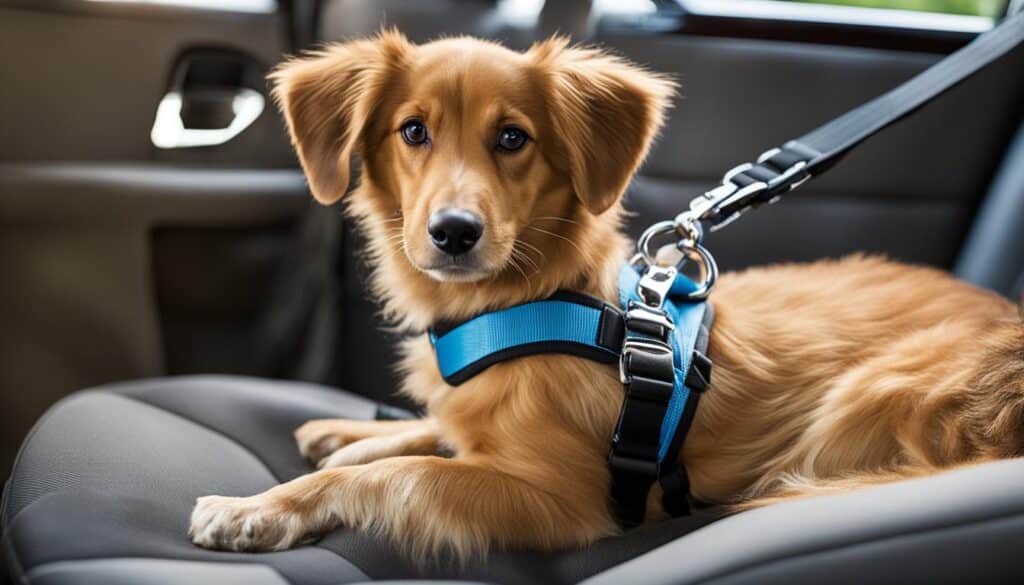
Proper Use of Restraints and Carriers
When it comes to ensuring your pet’s safety during car travel, proper use of restraints and carriers is crucial. To protect your furry friend from harm, it’s important to follow these guidelines:
- Avoid connecting the restraint to your pet’s collar. This can cause neck injuries if there is sudden braking or a collision. Instead, use a harness specifically designed for car travel, which distributes force more evenly across your pet’s body.
- Never place your pet in the front seat of the car. Airbags are designed for the protection of humans and can pose a significant risk to pets. The force of the deploying airbag can cause serious injuries or even be fatal to your furry friend.
- Putting your pet in the cargo area of the car is also not recommended. This area may lack proper ventilation and can be uncomfortable for your pet during the journey. Additionally, if the cargo area is not secured, your pet could be at risk of injury in the event of sudden stops or turns.
By following these guidelines, you can ensure your pet’s safety and make car travel a comfortable experience for both of you.
Feeding and Hydration During Car Travel
During car travel, it is crucial to prioritize your pet’s feeding schedule and ensure they stay hydrated to keep them comfortable and healthy. Follow these essential tips to make mealtimes and hydration a breeze for your furry friend:
1. Feed them a light meal before departure
To prevent car sickness, feed your pet a light meal three to four hours before you hit the road. This gives their stomach enough time to digest the food and reduces the chances of nausea or vomiting during the journey. Stick to their regular feeding schedule and avoid introducing new or unfamiliar foods before travel.
2. Make regular stops for meals
Just like humans, pets also need regular meals during long car trips. Plan your journey with designated stops where you can safely feed your pet. Choose pet-friendly rest areas or parks where your furry friend can stretch their legs and enjoy their meal in a calm and comfortable environment.
3. Prevent car sickness by avoiding feeding in a moving vehicle
Feeding your pet while the car is in motion can increase the risk of car sickness. Motion-induced nausea can lead to discomfort and even vomiting. It is best to avoid feeding your pet in a moving vehicle. Instead, stop at a safe location and allow your pet to enjoy their meal without any distractions or motion sickness.
4. Provide water during stops
Hydration is crucial for your pet’s well-being, especially during car travel. Offer them water during regular stops to ensure they stay refreshed and hydrated. You can carry a water bottle and a collapsible bowl, or use their regular water bowl from home. Remember to use clean water and replenish it as needed.
| Benefits of Maintaining a Pet Feeding Schedule During Car Travel | Preventing Car Sickness | Ensuring Hydration |
|---|---|---|
| 1. Provides familiarity and comfort for your pet | 1. Light meals before departure reduce the chances of nausea and vomiting | 1. Regular access to clean water prevents dehydration |
| 2. Maintains regular digestion and bowel movements | 2. Avoiding feeding in a moving vehicle reduces car sickness risks | 2. Hydration supports overall health and well-being during travel |
| 3. Reduces the likelihood of hunger-related anxiety and restlessness | 3. Decreases discomfort and stress for a smoother travel experience | 3. Helps regulate body temperature and aids in the proper functioning of organs |
By following these guidelines, you can ensure your pet’s feeding and hydration needs are met during car travel, promoting their comfort, health, and overall well-being.
Pet Safety in Different Weather Conditions
Temperature control is crucial for pet safety in various weather conditions. Whether it’s scorching heat or freezing cold, it’s essential to take precautions to keep your furry friend safe and comfortable during car travel. Here are some tips to ensure your pet’s well-being:
Avoid Leaving Your Pet in a Parked Car
Never leave your pet alone in a parked car, even for a short time. Temperatures can rise rapidly, reaching dangerous levels within minutes, even with cracked windows or shade. This can lead to heatstroke or suffocation, risking your pet’s life. It’s always best to bring your pet with you or leave them at home in a comfortable environment.
Maintain Proper Car Ventilation
When traveling with your pet in the car, ensure that the vehicle is well-ventilated. Keep the windows cracked or use the air conditioning system to provide a comfortable and safe environment. Proper ventilation helps regulate the temperature inside the car, preventing your pet from overheating or becoming too cold.
Consider Extreme Weather Conditions
In extreme weather conditions, such as heatwaves or cold snaps, it’s advisable to leave your pet at home instead of taking them on errands. High temperatures can quickly lead to heatstroke, while freezing temperatures can cause hypothermia. Prioritize your pet’s safety by avoiding unnecessary exposure to extreme weather.
Plan for Comfort
During car travel, ensure that your pet is comfortable. Use suitable bedding or a pet carrier to provide a cozy space for them. Consider using blankets or covers to protect them from direct sunlight or drafts. Making your pet feel secure and comfortable is essential for their overall well-being during the journey.
By following these guidelines, you can ensure the safety and comfort of your pet in different weather conditions. Remember that their well-being should always be a top priority during car travel.
Emergency Preparedness and Identification
When traveling with your pet, it’s crucial to be prepared for emergencies and ensure their identification is up to date. Taking these precautions will give you peace of mind and help keep your furry friend safe throughout your journey.
Also Read:- Best Family Car Models: Top Picks For Safety & Comfort
Pet Identification
Before embarking on your trip, make sure your pet’s identification information is current. Check that their collar has a visible and updated ID tag with your contact details. Additionally, consider microchipping your pet, as it provides a permanent form of identification that cannot be easily lost or removed. If your pet already has a microchip, verify that the information on it is correct and up to date.
Pet GPS Tracker
To further enhance your pet’s safety, investing in a pet GPS tracker is an excellent option. GPS trackers allow you to monitor your pet’s location in real time and provide accurate tracking if they happen to wander off or get lost. With a pet GPS tracker, you can quickly locate and reunite with your furry friend, even in unfamiliar surroundings.
Emergency Pet Supplies
It’s important to pack emergency supplies for your pet in case of unforeseen circumstances. These supplies should include a comprehensive pet first-aid kit, which includes essential items such as bandages, antiseptics, and tweezers. Additionally, bring any necessary medications your pet may require during the trip, as well as a copy of their prescription from their veterinarian. Don’t forget to pack enough food, water, and dishes for your furry friend, as well as waste disposal bags and toys to keep them comfortable and entertained.
Essential Emergency Pet Supplies
| Emergency Pet Supplies | Description |
|---|---|
| First-aid kit | A comprehensive kit containing bandages, antiseptics, tweezers, and other basic medical supplies. |
| Medications | Bring any necessary medications your pet requires during the trip, along with a copy of their prescription. |
| Food and water | Pack enough food and water for your pet, ensuring they have familiar and appropriate sustenance. |
| Food and water dishes | Include collapsible bowls or portable dishes for feeding and providing water to your pet. |
| Waste disposal bags | Carry waste disposal bags to clean up after your pet during the trip. |
| Toys | Bring your pet’s favorite toys to keep them entertained and comforted throughout the journey. |
By ensuring your pet’s identification is updated, using a pet GPS tracker, and packing emergency supplies, you’ll be well-prepared for any unexpected situations that may arise during your travels. These precautions will help keep your beloved pet safe, giving you peace of mind to enjoy your journey together.
Conclusion
Ensuring car safety for pets is crucial for a secure and comfortable travel experience. By following these pet safety tips, including using restraints or carriers, planning for stops, and being prepared for emergencies, you can prioritize your furry friend’s well-being and enjoy your journey together.
When traveling with pets, it is essential to keep them restrained in the back seat, away from airbags, to minimize distractions and risks. Choose certified crash-tested restraints or carriers to ensure maximum safety. Take short trips to acclimate your pet to car travel, and feed them a light meal before departure to prevent car sickness.
During stops, never leave your pet alone in a parked car. Pack a pet travel kit with their essentials, including health records, food, water, medications, and toys. Additionally, avoid hazards like letting your pet ride with their head out of the window or feeding them while driving.
Remember to maintain their feeding schedule and provide hydration during car travel. Ensure a well-ventilated environment and avoid extreme temperatures. Before your journey, update your pet’s identification and consider using a pet GPS tracker for added security and peace of mind.
Traveling with pets can be enjoyable and worry-free when you prioritize their safety. With proper preparation and care, you can make car travel a positive experience for both you and your furry companion.
FAQs
Q: What are the best ways to keep your dog safe while traveling in a car?
A: You can keep your dog safe in the car by using a safety harness, car seat, or crate specifically designed for pets. Make sure the product is appropriate for your dog’s size and weight.
Q: Why is it important to restrain your dog while traveling in a car?
A: Restraining your dog in the car is crucial for their safety and the safety of the passengers. Unrestrained pets can be seriously injured or cause accidents in the event of sudden stops or crashes.
Q: What are the hazards for dogs traveling in cars?
A: Dogs can be at risk of getting injured during sudden stops, turns, or accidents if they are not properly restrained. Additionally, they may be more prone to motion sickness if they are not securely positioned.
Q: What are the recommended safety tips for traveling with a dog in a car?
A: Always secure your dog in the back seat to avoid airbag injuries, never leave your dog unattended in a parked car, and make frequent stops for bathroom breaks, hydration, and exercise.
Q: What are the best ways to safely restrain your dog in a car?
A: You can safely restrain your dog in a car using a seat belt harness, travel crate, dog car seat, or car barrier. Each method should be chosen based on your dog’s size, temperament, and comfort.
Q: Is it safe for dogs to put their head out of the car window while traveling?
A: It’s not safe for dogs to stick their head out of the car window. Debris or insects could hit them, and sudden stops or turns could lead to injuries. Additionally, it’s best to keep them securely inside the car.
Q: What are the important factors to consider when choosing a safety harness for your dog in the car?
A: When choosing a safety harness for your dog, consider factors such as size and weight compatibility, ease of use, crash safety standards, and adjustability for a secure and comfortable fit.
Q: Are there specific safety standards or regulations for pet car safety products?
A: While there are no federal regulations, many pet car safety products are tested for crash safety and may adhere to voluntary standards set by independent organizations, ensuring their effectiveness.
Q: Can it be harmful to leave your dog unattended in a parked car?
A: It can be harmful to leave your dog unattended in a parked car, especially in extreme temperatures. The interior of a car can quickly become dangerously hot or cold, posing a serious risk to your pet’s health.
Q: What should pet parents do to ensure their dogs are safe and secure during car travel?
A: Pet parents should invest in proper pet car safety products, never let their dogs roam freely inside the car, and prioritize their dog’s comfort and safety by restraining them securely and providing necessary breaks during travel.
Source Links
- https://www.webmd.com/pets/dogs/how-to-travel-with-your-dog
- https://www.locallifesc.com/keep-your-pets-safe-with-these-car-travel-tips/
- https://www.petassure.com/maxscorner/car-travel-with-pets/